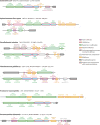Evolutionary Genomics of Defense Systems in Archaea and Bacteria
- PMID: 28657885
- PMCID: PMC5898197
- DOI: 10.1146/annurev-micro-090816-093830
Evolutionary Genomics of Defense Systems in Archaea and Bacteria
Abstract
Evolution of bacteria and archaea involves an incessant arms race against an enormous diversity of genetic parasites. Accordingly, a substantial fraction of the genes in most bacteria and archaea are dedicated to antiparasite defense. The functions of these defense systems follow several distinct strategies, including innate immunity; adaptive immunity; and dormancy induction, or programmed cell death. Recent comparative genomic studies taking advantage of the expanding database of microbial genomes and metagenomes, combined with direct experiments, resulted in the discovery of several previously unknown defense systems, including innate immunity centered on Argonaute proteins, bacteriophage exclusion, and new types of CRISPR-Cas systems of adaptive immunity. Some general principles of function and evolution of defense systems are starting to crystallize, in particular, extensive gain and loss of defense genes during the evolution of prokaryotes; formation of genomic defense islands; evolutionary connections between mobile genetic elements and defense, whereby genes of mobile elements are repeatedly recruited for defense functions; the partially selfish and addictive behavior of the defense systems; and coupling between immunity and dormancy induction/programmed cell death.
Keywords: CRISPR-Cas; adaptive immunity; antivirus defense; dormancy; innate immunity; mobile genetic elements; programmed cell death; restriction-modification; toxins-antitoxins.
Figures





References
-
- Amitai G, Sorek R. CRISPR-Cas adaptation: insights into the mechanism of action. Nat Rev Microbiol. 2016;14:67–76. - PubMed
Publication types
MeSH terms
Substances
Grants and funding
LinkOut - more resources
Full Text Sources
Other Literature Sources
Molecular Biology Databases

